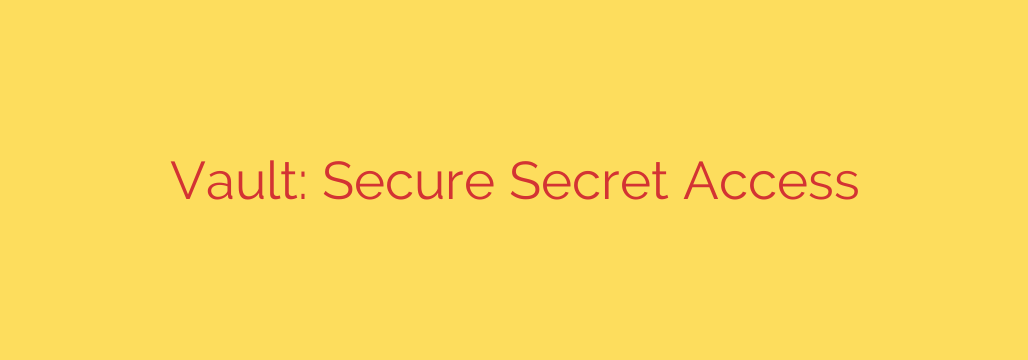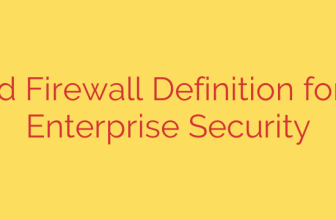
Mastering Secrets Management: A Guide to Securing Your Digital Infrastructure
In today’s complex digital landscape, applications and services are constantly communicating with each other. This communication is powered by a hidden layer of credentials known as “secrets”—API keys, database passwords, tokens, and TLS certificates. How you manage these secrets can be the deciding factor between a secure, resilient system and one that is vulnerable to catastrophic breaches.
Unfortunately, many organizations still rely on outdated and dangerous methods for handling secrets, leading to a problem known as “secret sprawl.” This is the uncontrolled distribution of sensitive credentials across configuration files, source code, and even internal wikis. The result is a massive, unmanageable security risk.
This guide explores the core principles of modern secrets management, outlining why it is critical for your security posture and how to implement it effectively.
What Exactly Are “Secrets”?
Before diving into management strategies, it’s essential to understand what constitutes a secret in a development and IT context. A secret is any piece of information that grants privileged access to a system, service, or set of data.
Common examples include:
- API keys for third-party services (e.g., payment gateways, cloud providers).
- Database credentials (usernames and passwords).
- Private encryption keys and SSL/TLS certificates.
- Access tokens for APIs and applications.
- SSH keys for server access.
Leaking any of these secrets can provide an attacker with a direct pathway into your most sensitive systems.
The Dangers of Secret Sprawl: Why Traditional Methods Fail
For years, developers have stored secrets in plain text configuration files, environment variables, or worse, hardcoded directly into the application source code. While convenient in the short term, these methods create significant long-term risks.
- Hardcoded Credentials: Embedding secrets in source code is one of the most severe security anti-patterns. Once committed to a version control system like Git, that secret is permanently part of the project’s history, even if you remove it later. A single leak of your source code repository exposes every secret within it.
- Configuration Files: Storing secrets in
.envor.configfiles is common, but these files are often accidentally committed to version control or left on unsecured servers, making them an easy target for attackers. - Lack of Auditing: When secrets are scattered everywhere, it’s impossible to know who accessed what, and when. This lack of an audit trail makes it incredibly difficult to respond to a security incident or meet compliance requirements.
- Difficult Rotation: Manually updating a password or API key across dozens of applications is tedious and error-prone. As a result, secrets are rarely changed, leaving long-lived credentials active for months or even years.
These challenges highlight the need for a centralized, secure, and automated approach to managing sensitive information.
The Pillars of Modern Secrets Management
A robust secrets management solution is built on several key pillars that work together to secure your entire infrastructure. The goal is to treat secrets as first-class citizens, providing them with the same level of protection as your most valuable data.
1. Centralized and Secure Storage
The foundation of any good strategy is a single, secure vault for all secrets. Instead of being scattered, all credentials are stored in one place. This central vault must provide strong encryption for data both at rest and in transit, ensuring that even if the storage system itself is compromised, the secrets remain unreadable.
2. Dynamic Secrets
Static, long-lived credentials are a liability. Dynamic secrets are a game-changer for security. A modern secrets management system can generate unique credentials on-demand for a specific user or application. These secrets are configured with a short time-to-live (TTL), meaning they automatically expire after a few minutes or hours. This dramatically reduces the risk posed by a leaked credential, as it will be invalid by the time an attacker finds it.
3. Granular Access Control and Authentication
Not every user or application needs access to every secret. A centralized system allows you to enforce the principle of least privilege through strict, policy-based access controls. You can define precisely which systems are authorized to request specific secrets. Authentication can be tied to trusted platforms like AWS IAM, Kubernetes, or other identity providers, ensuring that only verified clients can access the vault.
4. Comprehensive Auditing
A robust secrets management solution keeps a detailed log of every action. This audit trail records every authentication attempt and every request to read or write a secret. This detailed logging is invaluable for security forensics and compliance. In the event of a breach, you can quickly determine which credentials were compromised and take immediate action.
Actionable Security Tips for Implementing Secrets Management
Moving to a modern secrets management platform is a critical step in maturing your security posture. Here are some actionable tips to get started:
- Conduct a Secret Audit: Your first step is to identify where all your current secrets live. Scan your source code repositories, configuration management tools, and servers to find hardcoded credentials and other insecurely stored secrets.
- Embrace Automation: Integrate your secrets management tool directly into your CI/CD pipeline. Applications should fetch credentials automatically at runtime rather than having them injected during the build process. This prevents secrets from being stored in logs or build artifacts.
- Prioritize Dynamic Secrets: For services that support it (like databases and cloud platforms), prioritize the use of dynamic, short-lived credentials. This is one of the single most effective ways to reduce your attack surface.
- Implement a Rotation Policy: For any static secrets that remain, establish a strict and automated rotation policy. Ensure that API keys and other long-lived credentials are automatically revoked and replaced on a regular schedule.
By moving away from the fragile and risky practices of the past, you can build a more secure, compliant, and resilient infrastructure. Centralizing control, automating access, and ensuring visibility are no longer optional—they are essential components of modern digital security.
Source: https://www.linuxlinks.com/vault-tool-securely-accessing-secrets/








